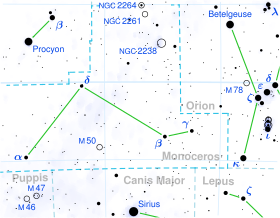Epsilon Monocerotis
Binary star system in the constellation Monoceros
  | |
| Observation data Epoch J2000 Equinox | |
|---|---|
| Constellation | Monoceros |
| ε Mon A | |
| Right ascension | 06h 23m 46.08471s[1] |
| Declination | 4° 35′ 34.3153″[1] |
| Apparent magnitude (V) | 4.39[2] |
| ε Mon B | |
| Right ascension | 06h 23m 46.48292s[1] |
| Declination | 4° 35′ 45.2307″[1] |
| Apparent magnitude (V) | 6.72[2] |
| Characteristics | |
| ε Mon A | |
| Spectral type | class = A5 IV[3] |
| U−B color index | +0.14[4] |
| B−V color index | +0.20[4] |
| ε Mon B | |
| Spectral type | F5 V[3] |
| U−B color index | −0.05[5] |
| B−V color index | +0.45[5] |
| Astrometry | |
| ε Mon A | |
| Radial velocity (Rv) | +13.10[6] km/s |
| Proper motion (μ) | RA: −22.06[1] mas/yr Dec.: +10.91[1] mas/yr |
| Parallax (π) | 26.67 ± 0.90 mas[1] |
| Distance | 122 ± 4 ly (37 ± 1 pc) |
| Absolute magnitude (MV) | 1.52[2] |
| ε Mon B | |
| Radial velocity (Rv) | +12.40[6] km/s |
| Proper motion (μ) | RA: −21.86[1] mas/yr Dec.: +11.35[1] mas/yr |
| Parallax (π) | 26.95 ± 0.99 mas[1] |
| Distance | 121 ± 4 ly (37 ± 1 pc) |
| Absolute magnitude (MV) | +3.88[2] |
| Details | |
| ε Mon A | |
| Mass | 2.04[7] M☉ |
| Radius | 2.5[8] R☉ |
| Luminosity | 25[7] L☉ |
| Surface gravity (log g) | 3.95[9] cgs |
| Temperature | 7,923[9] K |
| Metallicity [Fe/H] | −0.11[10] dex |
| Rotational velocity (v sin i) | 149[7] km/s |
| ε Mon B | |
| Mass | 1.16[8] M☉ |
| Radius | 1.1[8] R☉ |
| Luminosity | 2.39[2] L☉ |
| Surface gravity (log g) | 3.95[9] cgs |
| Temperature | 7,923[9] K |
| Rotational velocity (v sin i) | 25[3] km/s |
| Other designations | |
| ε Mon A: BD+04° 1236, FK5 244, GC 8240, HD 44769, HIP 30419, HR 2298, SAO 113810 | |
| ε Mon B: BD+04° 1237, FK5 244, GC 8241, HD 44770, HIP 30422, HR 2299, SAO 113811 | |
| Database references | |
| SIMBAD | data |
| SIMBAD | data |
ε Monocerotis, Latinised as Epsilon Monocerotis, is the Bayer designation of a binary star system in the equatorial constellation Monoceros. Its location is a guide for sky navigation toward the Rosette Nebula.[11]
The white-hued primary component has a stellar classification of A5 IV,[3] suggesting it is an aging subgiant star. Its apparent magnitude is 4.39[2] and it is approximately 122 light years away based on parallax.[1] It is reportedly a spectroscopic binary with a period around 331 days.[12]
The B component, at a separation of around 12.3",[12] is a yellow-white hued F-type main-sequence star of class F5 V[3] and an apparent magnitude of 6.72.[2]
References
- ^ a b c d e f g h i j k Van Leeuwen, F. (2007). "Validation of the new Hipparcos reduction". Astronomy and Astrophysics. 474 (2): 653–664. arXiv:0708.1752. Bibcode:2007A&A...474..653V. doi:10.1051/0004-6361:20078357. S2CID 18759600. Vizier catalog entry A Vizier catalog entry B
- ^ a b c d e f g Anderson, E.; Francis, Ch. (2012). "XHIP: An extended hipparcos compilation". Astronomy Letters. 38 (5): 331. arXiv:1108.4971. Bibcode:2012AstL...38..331A. doi:10.1134/S1063773712050015. S2CID 119257644. Vizier catalog entry A Vizier catalog entry B
- ^ a b c d e Hoffleit, D.; Warren, W. H. (1995). "VizieR Online Data Catalog: Bright Star Catalogue, 5th Revised Ed. (Hoffleit+, 1991)". VizieR On-line Data Catalog: V/50. Originally Published in: 1964BS....C......0H. 5050. Bibcode:1995yCat.5050....0H.
- ^ a b Mallama, A. (2014). "Sloan Magnitudes for the Brightest Stars". The Journal of the American Association of Variable Star Observers. 42 (2): 443. Bibcode:2014JAVSO..42..443M.Vizier catalog entry
- ^ a b Mermilliod, J. C. (2006). "VizieR Online Data Catalog: Homogeneous Means in the UBV System (Mermilliod 1991)". VizieR On-line Data Catalog: II/168. Originally Published in: Institut d'Astronomie. 2168. Bibcode:2006yCat.2168....0M.Vizier catalog entry
- ^ a b Gontcharov, G. A. (2006). "Pulkovo Compilation of Radial Velocities for 35 495 Hipparcos stars in a common system". Astronomy Letters. 32 (11): 759–771. arXiv:1606.08053. Bibcode:2006AstL...32..759G. doi:10.1134/S1063773706110065. S2CID 119231169.
- ^ a b c Zorec, J.; Royer, F. (2012). "Rotational velocities of A-type stars". Astronomy & Astrophysics. 537: A120. arXiv:1201.2052. Bibcode:2012A&A...537A.120Z. doi:10.1051/0004-6361/201117691. S2CID 55586789. Vizier catalog entry
- ^ a b c Allende Prieto, C.; Lambert, D. L. (1999). "Fundamental parameters of nearby stars from the comparison with evolutionary calculations: Masses, radii and effective temperatures". Astronomy and Astrophysics. 352: 555–562. arXiv:astro-ph/9911002. Bibcode:1999A&A...352..555A.
- ^ a b c d David, Trevor J.; Hillenbrand, Lynne A. (2015). "The Ages of Early-Type Stars: Strömgren Photometric Methods Calibrated, Validated, Tested, and Applied to Hosts and Prospective Hosts of Directly Imaged Exoplanets". The Astrophysical Journal. 804 (2): 146. arXiv:1501.03154. Bibcode:2015ApJ...804..146D. doi:10.1088/0004-637X/804/2/146. S2CID 33401607.
- ^ Wu, Yue; Singh, H. P.; Prugniel, P.; Gupta, R.; Koleva, M. (2010). "Coudé-feed stellar spectral library – atmospheric parameters". Astronomy & Astrophysics. 525: A71. arXiv:1009.1491. Bibcode:2011A&A...525A..71W. doi:10.1051/0004-6361/201015014. S2CID 53480665.
- ^ Kaler, James. "EPS MON (Epsilon Monocerotis)". STARS. University of Illinois. Retrieved 2017-12-23.
- ^ a b Mason, Brian D.; Wycoff, Gary L.; Hartkopf, William I.; Douglass, Geoffrey G.; Worley, Charles E. (2001). "The 2001 US Naval Observatory Double Star CD-ROM. I. The Washington Double Star Catalog". The Astronomical Journal. 122 (6): 3466. Bibcode:2001AJ....122.3466M. doi:10.1086/323920. Vizier catalog entry
- v
- t
- e
Constellation of Monoceros
| Bayer | |
|---|---|
| Flamsteed | |
| Variable | |
| HR |
|
| HD | |
| Other |
| Exoplanets |
|---|
clusters
| NGC | |
|---|---|
| Other |
| NGC | |
|---|---|
| Other |
| NGC |
|---|
 Category
Category











